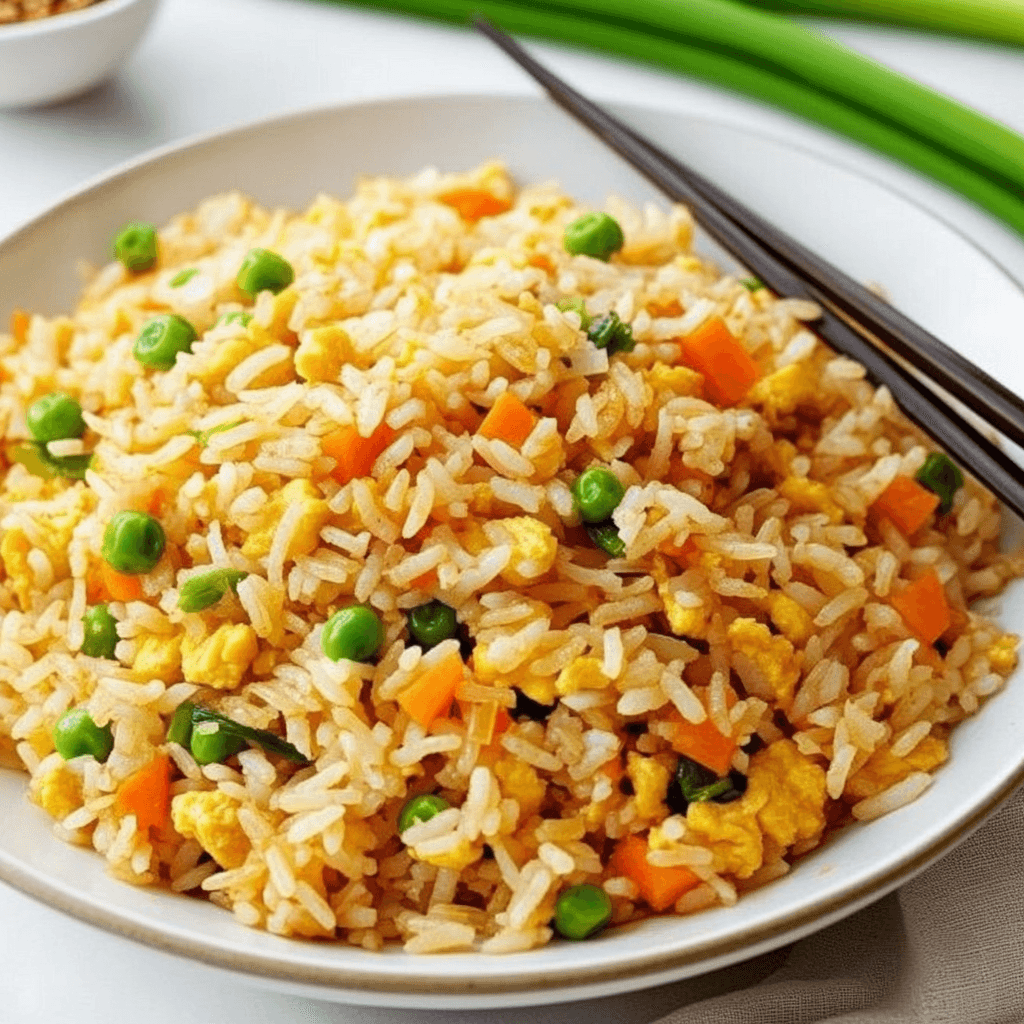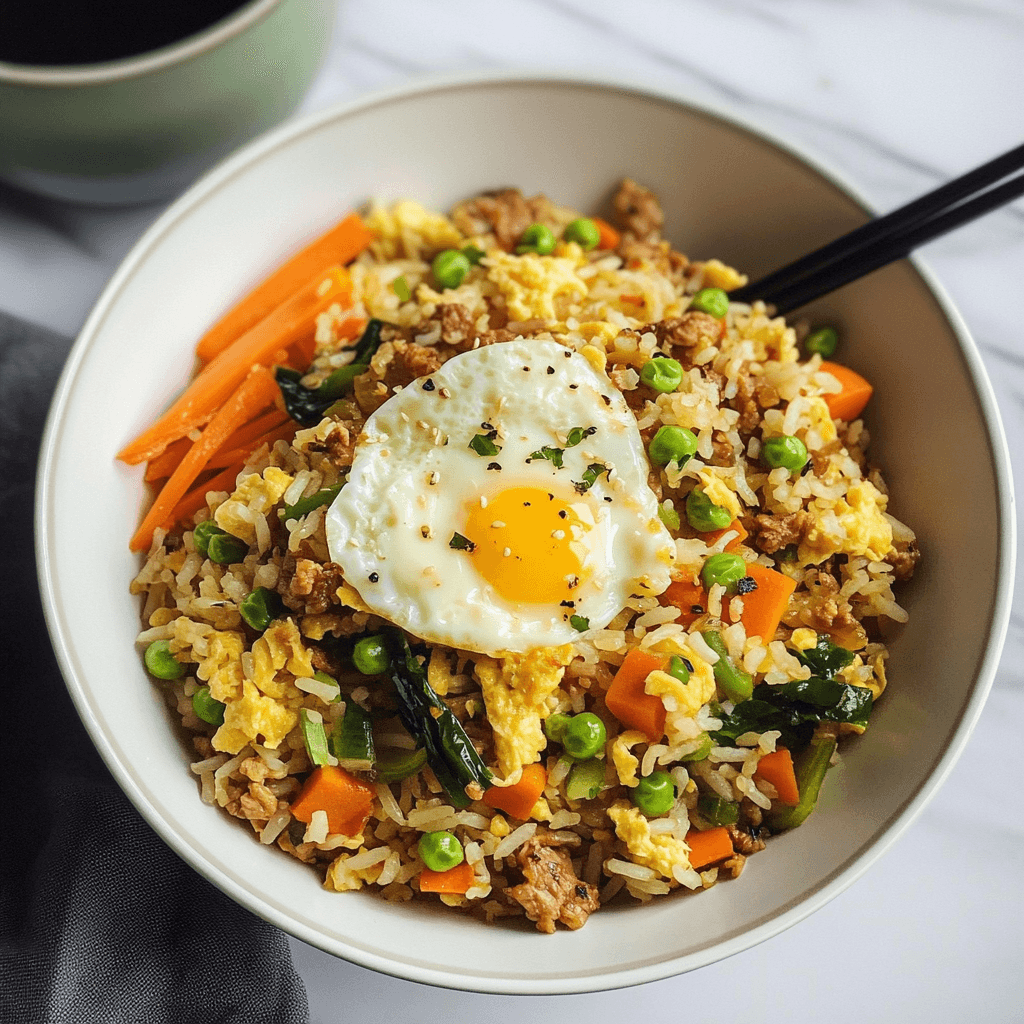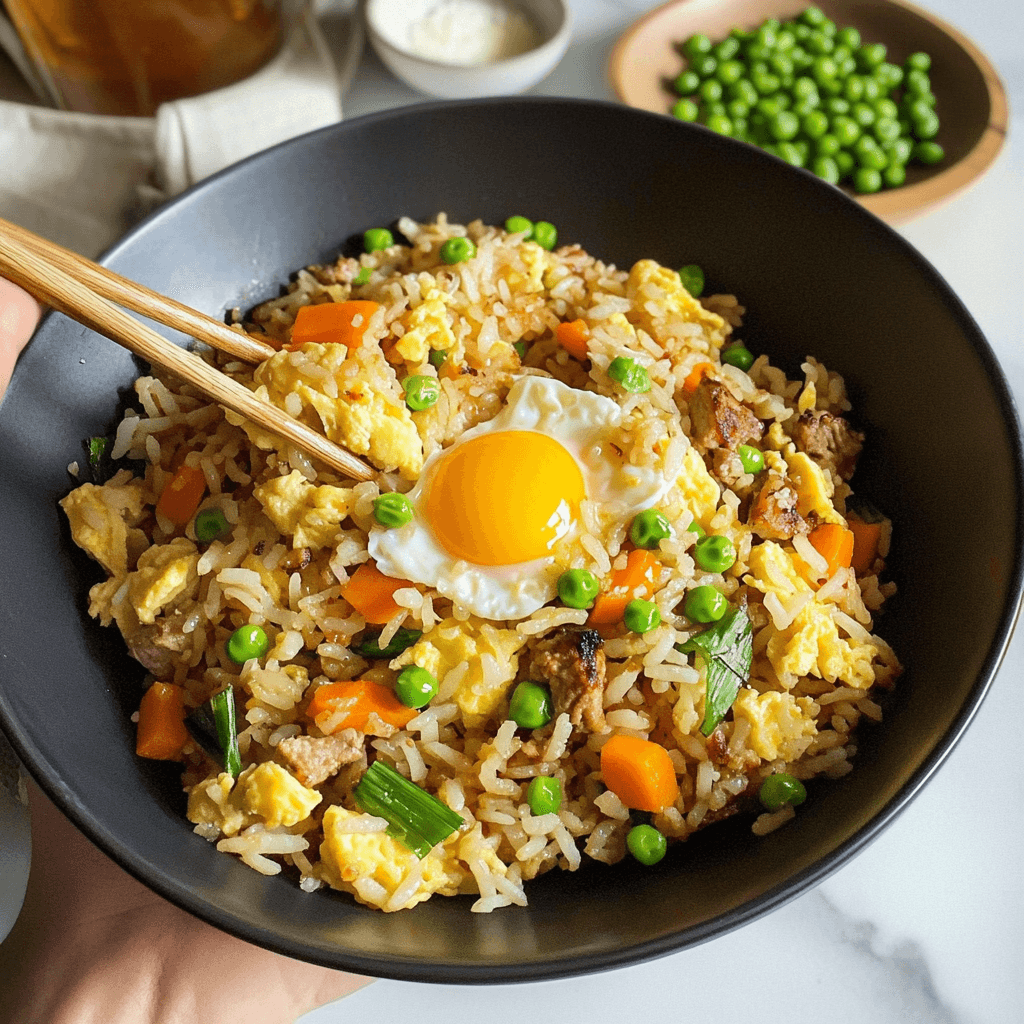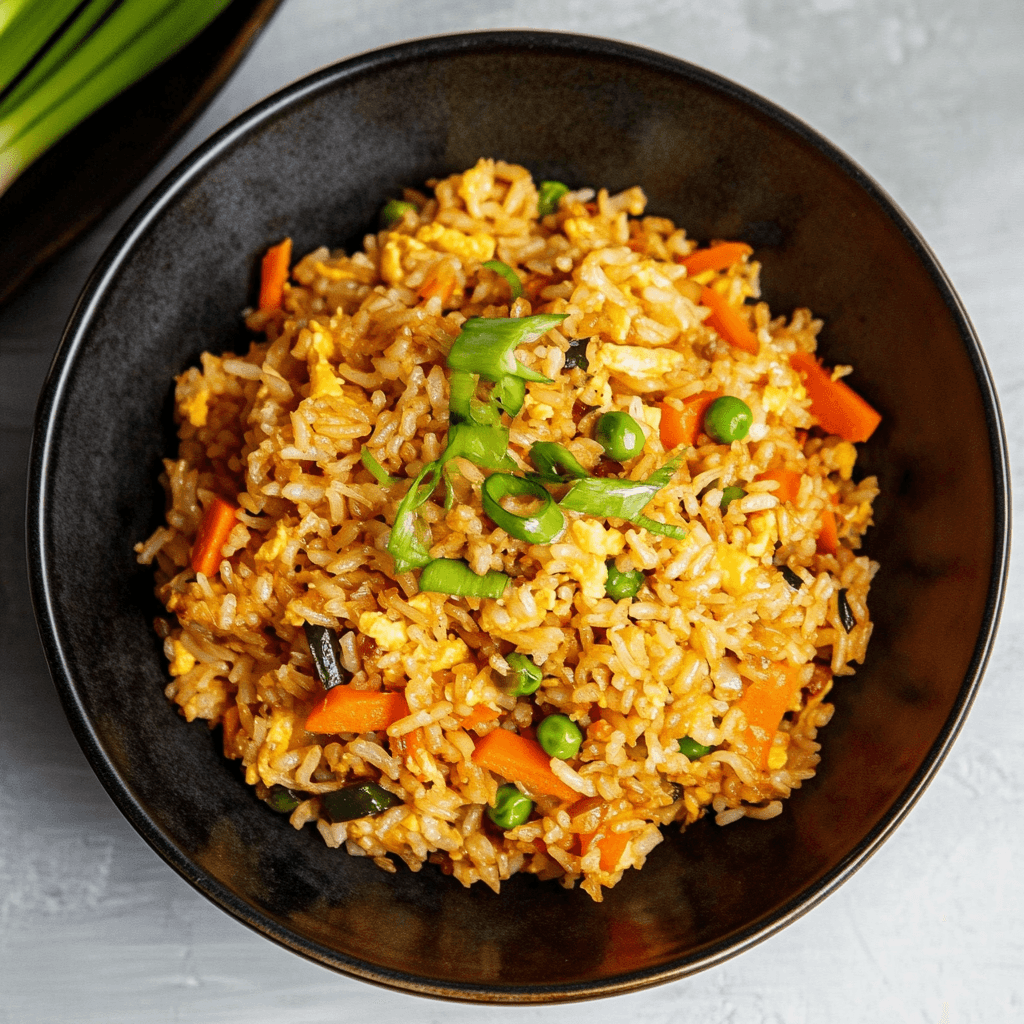Fried rice is a culinary treasure with roots that span centuries and continents. What began as a practical way to use up leftover rice in ancient China has evolved into a globally adored dish, renowned for its versatility, flavor, and ease of preparation. Found in nearly every cuisine—from the savory soy-based Chinese versions to the tangy, lime-infused Thai variations—fried rice is a blank canvas for creativity.
This dish is a true testament to the idea that simple ingredients, when combined with the right techniques, can create something extraordinary. Whether you’re a seasoned home cook or a beginner in the kitchen, fried rice offers an opportunity to experiment with flavors, textures, and cultural influences. It can transform humble pantry staples like rice, vegetables, and eggs into a gourmet meal, perfect for any occasion.
The beauty of fried rice lies not only in its ability to adapt to diverse palates but also in its practicality. It’s quick to make, uses ingredients you likely already have, and minimizes food waste by repurposing leftovers. Its universal appeal and endless customizations make fried rice a staple in kitchens worldwide. Ready to learn the secrets to making this iconic dish? Let’s dive into its essential components, variations, and step-by-step preparation techniques.

What Is Fried Rice?
Fried rice originated in ancient China as a clever way to repurpose leftover rice. It has since evolved into a staple in various cuisines, from Thai pineapple fried rice to Japanese soy butter fried rice. A hallmark of its versatility, this dish can adapt to almost any taste preference or dietary need.
To start your culinary journey, it’s essential to understand the importance of using properly cooked rice. For more information, consider this helpful guide to preparing rice for perfect results. Also, learn about the health benefits of sesame oil, a staple seasoning that adds depth and richness to fried rice.
Essential Components of Fried Rice
Key Ingredients
The magic of fried rice lies in its customizability. However, these core components form the foundation of any great recipe:
- Rice: Ideally, use day-old rice for a drier, non-sticky texture.
- Proteins: Common options include chicken, shrimp, eggs, or tofu.
- Vegetables: Popular choices are carrots, peas, onions, and scallions.
- Seasonings: Soy sauce, sesame oil, garlic, and ginger add depth and umami.
Explore creative protein combinations, like those in this Mexican-inspired chicken rice bowl, to elevate your fried rice to the next level.

Tools and Techniques
The right tools and techniques make all the difference in achieving restaurant-quality fried rice:
- Use a wok for even heat distribution and the signature smoky flavor, known as “wok hei.”
- Cook ingredients at high heat and in stages to prevent steaming.
- Break up rice clumps before adding them to the pan.
- Stir continuously for even cooking and flavor distribution.
Popular Fried Rice Variations
Fried rice recipes vary widely across cultures. Here are some of the most beloved styles:
- Chinese Fried Rice: Includes barbecued pork, scrambled eggs, and peas for a balanced, savory taste.
- Thai Fried Rice: Features tangy fish sauce, lime, and sometimes pineapple or crab.
- Japanese Fried Rice: Combines soy butter for a rich, umami flavor.
- Western Adaptations: Bacon fried rice and BBQ chicken fried rice cater to diverse palates.
For a tropical twist, consider this Hawaiian-inspired slow cooker chicken dish, which pairs beautifully .
Step-by-Step Recipe for Classic Fried Rice
Ingredients:
- 3 cups of leftover rice (cold and firm)
- 2 tablespoons of sesame oil
- 1 teaspoon of minced garlic
- 1 cup of diced mixed vegetables
- 2 eggs, whisked
- 1 cup of cooked protein (shrimp, chicken, or tofu)
- 2 tablespoons of soy sauce
Instructions:
- Heat sesame oil in a wok over medium-high heat.
- Add garlic and stir until fragrant.
- Cook the protein until browned, then set aside.
- Scramble the eggs lightly and remove from the wok.
- Toss in the rice, breaking up clumps, and fry for 2-3 minutes.
- Add vegetables, cooked protein, and soy sauce. Stir-fry for another 3 minutes.
- Garnish with scallions and serve immediately.
Nutritional Benefits and Variations
This dish is a blank slate for nutritional adaptations:
- High-Protein Options: Include shrimp, chicken, or tofu for a protein-packed meal.
- Vegetarian-Friendly: Replace meat with additional vegetables or plant-based proteins.
- Low-Carb Variations: Swap rice for cauliflower rice for a lighter alternative.
Creative Serving Ideas
This dish is incredibly versatile and pairs well with various dishes:
- Serve alongside dumplings or spring rolls for a complete Asian-inspired feast.
- Pair with grilled meats or seafood for a hearty, balanced plate.
- Use as a base for fusion dishes, like tropical poke bowls or Tex-Mex burritos.
For an authentic flavor, try using elements from this Thai green curry recipe.

FAQs
1. Why use leftover rice for fried rice?
Leftover rice is drier and less sticky than freshly cooked rice, which helps ensure each grain stays separate and absorbs the seasonings evenly. Freshly cooked rice tends to be too moist and can result in clumpy, soggy fried rice. If you only have fresh rice, spread it out on a baking sheet and refrigerate for 1–2 hours before using.
2. Can fried rice be frozen?
Yes! Fried rice freezes well and makes a convenient meal prep option.
- How to freeze: Let the fried rice cool completely, then portion it into airtight freezer-safe containers or resealable bags.
- Reheating: Reheat directly from frozen in a microwave or stovetop. Add a splash of water or broth while reheating to restore moisture.
3. How can I make fried rice healthier?
- Reduce sodium: Use low-sodium soy sauce or tamari.
- Add veggies: Increase the vegetable content by adding carrots, peas, broccoli, bell peppers, or leafy greens.
- Cut back on oil: Use a nonstick pan or substitute oil with a light spray of cooking oil.
- Use brown rice: Swap white rice for fiber-rich brown rice or quinoa for a healthier alternative.
4. What type of rice is best for fried rice?
Medium- to long-grain rice, such as jasmine or basmati, works best because the grains are less sticky and separate easily. Short-grain rice can be used but tends to clump together.
5. Can I make fried rice without a wok?
Absolutely! While a wok is ideal because it distributes heat evenly, you can use a large skillet or frying pan. Just ensure it’s wide enough to allow for proper stir-frying without overcrowding the pan.
6. How do I prevent fried rice from sticking to the pan?
- Preheat your pan or wok before adding oil.
- Use a nonstick pan if possible.
- Keep the pan on high heat while continuously stirring to prevent sticking.
- Avoid overcrowding the pan, as this can cause the ingredients to release too much moisture.
7. What proteins work best for fried rice?
Fried rice is versatile and pairs well with various proteins:
- Meat: Chicken, beef, pork, or shrimp.
- Eggs: Scrambled eggs are a classic addition and a great protein source.
- Plant-based: Tofu, tempeh, or edamame for vegetarian options.
8. How can I add extra flavor to fried rice?
- Seasoning: In addition to soy sauce, try oyster sauce, sesame oil, or hoisin sauce for depth.
- Aromatics: Use garlic, ginger, and onions for a fragrant base.
- Toppings: Garnish with chopped green onions, sesame seeds, or a drizzle of chili oil.
9. How long can I store leftover fried rice?
- In the refrigerator: Store in an airtight container for up to 3–4 days.
- In the freezer: Store for up to 3 months. Ensure it’s cooled completely before freezing.
10. Can I use freshly cooked rice if I don’t have leftovers?
Yes, but for the best texture, spread the rice out on a tray and let it cool in the refrigerator for at least 1–2 hours. This dries the rice slightly and prevents clumping.
Conclusion
This dish is more than just a dish—it’s a culinary masterpiece that embodies creativity, adaptability, and delicious simplicity. From its humble beginnings in ancient China to becoming a beloved global staple,This dish has proven its versatility across countless cuisines. Its ability to transform basic ingredients into a flavorful, satisfying meal makes it a favorite for home cooks and chefs alike.
Whether you’re creating a quick dinner for a busy weeknight, exploring new flavors with international variations, or repurposing leftovers into something extraordinary, This dishoffers endless possibilities. By mastering the right techniques—like using leftover rice, layering ingredients, and cooking at high heat—you can achieve restaurant-quality results every time.
The beauty of dish lies in its flexibility. You can tailor it to your preferences, making it as indulgent or as healthy as you wish. From classic Chinese-style rice to bold, tangy Thai versions or even Western adaptations like bacon, there’s a recipe to suit every palate. Moreover, This dish pairs seamlessly with a variety of dishes, from grilled proteins to dumplings and soups, making it a perfect centerpiece or a complementary side.
As you embark on your dish journey, remember that the dish thrives on experimentation. Try blending inspirations from recipes like a Hawaiian slow cooker chicken dish or a Thai green curry to create your own unique version.
This dish is a celebration of simplicity and flavor, reminding us that even the simplest ingredients can be transformed into something extraordinary with the right techniques and a touch of imagination. So grab your wok, gather your ingredients, and let the sizzling sound of inspire your culinary creativity.
